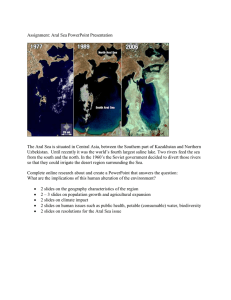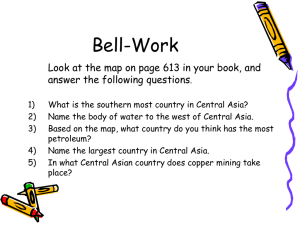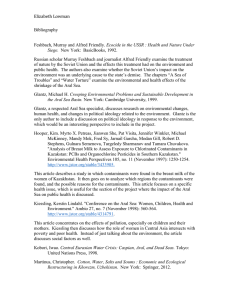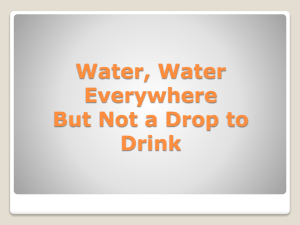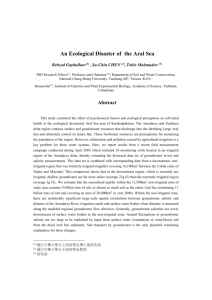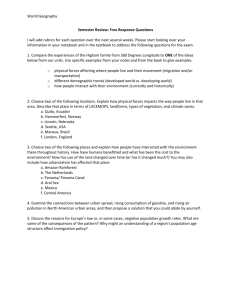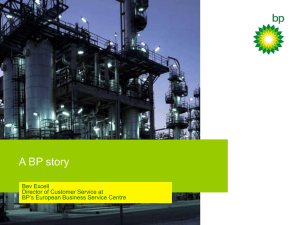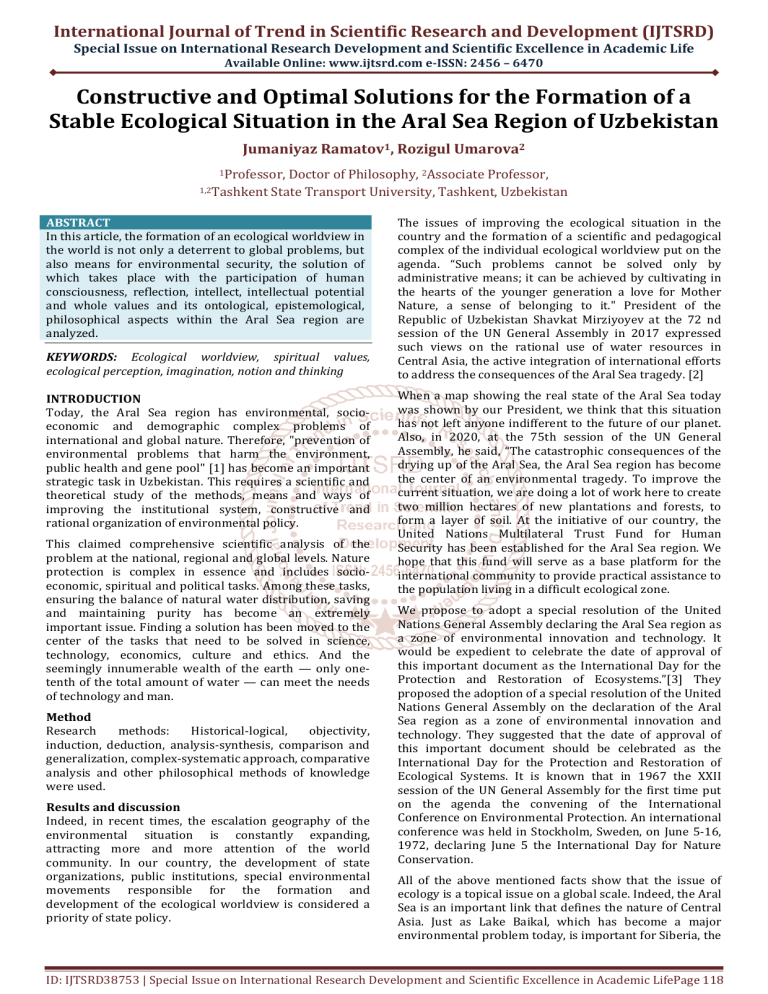
International Journal of Trend in Scientific Research and Development (IJTSRD)
Special Issue on International Research Development and Scientific Excellence in Academic Life
Available Online: www.ijtsrd.com e-ISSN: 2456 – 6470
Constructive and Optimal Solutions for the Formation of a
Stable Ecological Situation in the Aral Sea Region of Uzbekistan
Jumaniyaz Ramatov1, Rozigul Umarova2
1Professor,
1,2Tashkent
Doctor of Philosophy, 2Associate Professor,
State Transport University, Tashkent, Uzbekistan
ABSTRACT
In this article, the formation of an ecological worldview in
the world is not only a deterrent to global problems, but
also means for environmental security, the solution of
which takes place with the participation of human
consciousness, reflection, intellect, intellectual potential
and whole values and its ontological, epistemological,
philosophical aspects within the Aral Sea region are
analyzed.
KEYWORDS: Ecological worldview, spiritual values,
ecological perception, imagination, notion and thinking
INTRODUCTION
Today, the Aral Sea region has environmental, socioeconomic and demographic complex problems of
international and global nature. Therefore, "prevention of
environmental problems that harm the environment,
public health and gene pool" [1] has become an important
strategic task in Uzbekistan. This requires a scientific and
theoretical study of the methods, means and ways of
improving the institutional system, constructive and
rational organization of environmental policy.
This claimed comprehensive scientific analysis of the
problem at the national, regional and global levels. Nature
protection is complex in essence and includes socioeconomic, spiritual and political tasks. Among these tasks,
ensuring the balance of natural water distribution, saving
and maintaining purity has become an extremely
important issue. Finding a solution has been moved to the
center of the tasks that need to be solved in science,
technology, economics, culture and ethics. And the
seemingly innumerable wealth of the earth — only onetenth of the total amount of water — can meet the needs
of technology and man.
Method
Research
methods:
Historical-logical,
objectivity,
induction, deduction, analysis-synthesis, comparison and
generalization, complex-systematic approach, comparative
analysis and other philosophical methods of knowledge
were used.
Results and discussion
Indeed, in recent times, the escalation geography of the
environmental situation is constantly expanding,
attracting more and more attention of the world
community. In our country, the development of state
organizations, public institutions, special environmental
movements responsible for the formation and
development of the ecological worldview is considered a
priority of state policy.
The issues of improving the ecological situation in the
country and the formation of a scientific and pedagogical
complex of the individual ecological worldview put on the
agenda. “Such problems cannot be solved only by
administrative means; it can be achieved by cultivating in
the hearts of the younger generation a love for Mother
Nature, a sense of belonging to it." President of the
Republic of Uzbekistan Shavkat Mirziyoyev at the 72 nd
session of the UN General Assembly in 2017 expressed
such views on the rational use of water resources in
Central Asia, the active integration of international efforts
to address the consequences of the Aral Sea tragedy. [2]
When a map showing the real state of the Aral Sea today
was shown by our President, we think that this situation
has not left anyone indifferent to the future of our planet.
Also, in 2020, at the 75th session of the UN General
Assembly, he said, “The catastrophic consequences of the
drying up of the Aral Sea, the Aral Sea region has become
the center of an environmental tragedy. To improve the
current situation, we are doing a lot of work here to create
two million hectares of new plantations and forests, to
form a layer of soil. At the initiative of our country, the
United Nations Multilateral Trust Fund for Human
Security has been established for the Aral Sea region. We
hope that this fund will serve as a base platform for the
international community to provide practical assistance to
the population living in a difficult ecological zone.
We propose to adopt a special resolution of the United
Nations General Assembly declaring the Aral Sea region as
a zone of environmental innovation and technology. It
would be expedient to celebrate the date of approval of
this important document as the International Day for the
Protection and Restoration of Ecosystems.”[3] They
proposed the adoption of a special resolution of the United
Nations General Assembly on the declaration of the Aral
Sea region as a zone of environmental innovation and
technology. They suggested that the date of approval of
this important document should be celebrated as the
International Day for the Protection and Restoration of
Ecological Systems. It is known that in 1967 the XXII
session of the UN General Assembly for the first time put
on the agenda the convening of the International
Conference on Environmental Protection. An international
conference was held in Stockholm, Sweden, on June 5-16,
1972, declaring June 5 the International Day for Nature
Conservation.
All of the above mentioned facts show that the issue of
ecology is a topical issue on a global scale. Indeed, the Aral
Sea is an important link that defines the nature of Central
Asia. Just as Lake Baikal, which has become a major
environmental problem today, is important for Siberia, the
ID: IJTSRD38753 | Special Issue on International Research Development and Scientific Excellence in Academic LifePage 118
International Journal of Trend in Scientific Research and Development (IJTSRD) @ www.ijtsrd.com eISSN: 2456-6470
Aral Sea is no less important for Central Asia, Kazakhstan,
and the Volga region.
The drying up of the Aral Sea is influenced by a number of
factors: The first is the expansion of irrigated agriculture
on the banks of rivers flowing into the Aral Sea. Although
in the early 1960s the irrigated area in the oases was 3.5
million hectares (1.6 million hectares in the Amudarya
oasis and 1.9 million hectares in the Syrdarya oasis), the
water reserves of the Aral Sea have not decreased
compared to the 1930s. Over the past 20 years, the
irrigated area has reached 2.4 million hectares in the
Amudarya oasis and 2.6 million hectares in the Syrdarya
oasis. Thus, the intensive expansion of irrigated areas was
the beginning of an environmental tragedy for both the
Aral Sea and the region.
Especially in the post-Amudarya years, the increase in
water intake from Turkmenistan by 7 km through the
Karakum Canal further complicated the fate of the Aral
Sea. As a result, the Aral Sea lost 24% of its water in the
60s and 70s and 54% in the 70s and 80s. The flora of
600,000 hectares of land in the delta of the Amu Darya
flowing into the Aral Sea has been completed. The main
reason for this is the influx of salt from the dried-up areas
of the Aral Sea.
The second reason is to save water from the Amudarya
and Syrdarya rivers. not to use and to collect the waters of
these rivers into artificial reservoirs. According to experts,
the Amudarya and Syrdarya rivers flow an average of 120
billion m3 a year. With this water, 12 million hectares of
land can be irrigated and farmed. Now 5 million hectares
of land are irrigated. In addition, water from other water
bodies, groundwater, is used for irrigation. Excess water
from irrigation is collected in dozens of reservoirs. In
particular, the Tukhtagul reservoir on the Naryn River can
collect 19.5 km, the Chordara on the Syrdarya - 5.2, the
Qairoqqum - 3.4, the Tuyamoyin on the Amudarya - 7.8
km.
It should be noted that as a result of the construction of
artificial reservoirs in our сountry, 2,600 villages and 165
cities were flooded. The total area of the reservoirs is
equal to the territory of France. [4] Currently, water
conservation is not sufficiently controlled. There is a need
to develop and implement a perfect, rigorous system of
accounting and control. Fertilizer, machinery, fuel, labor
resources should be allocated on the basis of a detailed
plan, just as water is allocated on the basis of norms for
each hectare or centner of field. It is necessary to set a
strict limit on the amount of water supplied to farms with
a differential approach to irrigated areas.
It is advisable to deduct the value of water used or wasted
from the total income or to develop an additional incentive
system for farming with less water than the norm.
Consequently, the widespread introduction of family and
brigade contracting on farms creates the organizational
conditions for water-efficient use of water, i.e., the
overtime work that the contract team receives at the end
of the year, withholding a certain amount of money for
overspending and wasting water, or using less water.
Knowing that there
interest in saving it,
contract between the
water would have
would be an additional material
and if this was strengthen in the
farm and the contractor, the use of
been viewed from a different
perspective, of course. Wastewater from overuse in
agriculture is causing serious environmental problems. In
particular, it falls into freshwater basins and pollutes
them, increasing the level of mineralization of
groundwater, salting of soils and their conversion into
swamps. The situation is particularly dire in the lower
reaches of the rivers. [4]
The government of Uzbekistan is working to eliminate the
consequences of the Aral Sea tragedy and ensure
biodiversity around the region. In particular, saxaul fields
are being built in the dry part of the Aral Sea. It is also
trying to attract more investment to the region, drawing
the attention of major international organizations to the
Aral Sea problem. Even 50 years ago, the Aral Sea
averaged 1,082 cubic km. There was a volume of water,
and the area was 68 thousand sq. km. It is also 55-58 cubic
km to the Aral Sea annually water was pouring. 2/3 of it
flowed from the Amudarya and 1 part from the Syrdarya.
The situation on the island was moderate, the salt content
of the water was 11-12 g per liter. This means that the
most moderate conditions for development were created
in the Aral Sea region. So what are we in for now? Now the
area has decreased by 10 times and the volume of water
by 15 times. The level of the island dropped to 29 meters.
More than 20 species of fish that could live in the Aral Sea
alone have become extinct. For comparison, in the 60s of
last century, up to 35 thousand tons of fish were caught
per year. Today, more than 100 million tons of sand, dust
and salt are extracted from the dried bottom of the Aral
Sea every year, hundreds of thousands of kilometers. Such
migrating salt and sand particles have been found in
countries such as Norway, Japan, the Pamirs, the Alay, the
Tien Shan, and the Arctic. [4] The first task before us now
is to ensure the sustainable protection of the health of the
population in the Aral Sea region, which is the first priority
in the face of environmental tragedies. 5 million hectares
that have dried up in the last 20 years. only 400 thousand
hectares of land. saxophones were planted on the ground.
So far, the focus on this issue has changed radically. For
example, from December 2018 to April this year, 650
thousand hectares saxaul seeds were sown on the ground,
1 million one hundred thousand hectares. The branches
were removed and the saxaul fields was ready for
planting. Saxaul is such a plant that if you plant it in seven
rows, it will be big enough to hold 90 percent sand in 5-7
years, and it will have the ability to reproduce on its own.
This is the first feature of the saxaul. Its second feature is
that the ecosystem in the area where the saxaul grows is
moderate. Third, biodiversity will increase in those areas.
[5]
Also, the joint program "Strengthening the living capacity
of the population affected by the Aral Sea tragedy through
the establishment of the Multilateral Fund for Human
Security for the Aral Sea Region" funded by the UN Human
Security Trust Fund and implemented by UN agencies [7]
over three years in three model districts contributes the
improving environmental safety.
Based on the experience of initiatives in Karakalpakstan in
2012-2016, the Council of Ministers of Karakalpakstan
recommended that Moynak, Takhtakor and Shumanay
districts, which are located in the areas of greatest
environmental risk and have a population of more than
123,000, be designated as model areas for the new Joint
Program. The implementation of the above-mentioned
ID: IJTSRD38753 | Special Issue on International Research Development and Scientific Excellence in Academic LifePage 119
International Journal of Trend in Scientific Research and Development (IJTSRD) @ www.ijtsrd.com eISSN: 2456-6470
projects may, albeit partially, solve the environmental
problems associated with the drying up of the Aral Sea.
Conclusion
As part of the initiative to address the consequences of the
tragedy caused by the drying up of the Aral Sea, today, as a
result of efforts in this direction, the Trust Fund was
established under the auspices of the United Nations.
Funds are being mobilized with the support of the leading
countries and international organizations.
As a result of these measures, the living standards of the
people of the Aral Sea region are improving. In this regard,
Uzbekistan is mobilizing all opportunities and resources to
settle this environmental tragedy. In particular, a number
of projects have been implemented in the Aral Sea region
over the past few years. In the arid zone of the sea, work is
underway to create new plantations and forests with a
total area of two million hectares, to form the soil layer.
The state program for the development of the Aral Sea
region for 2018-2021 has been adopted. First of all, it will
be possible to attract investments and strengthen
international cooperation in the implementation of joint
measures aimed at improving the ecology and living
conditions of the population of the Aral Sea region. At the
same time, it will be possible the introduction of
environmentally friendly technologies, the complex
application of the "green economy" principles. In addition,
mitigation of the effects of climate change for the Aral Sea
region, the use of energy and water-saving technologies
and the development of ecotourism will be provided.
List of used literature:
[1] Mirziyoev Sh.M. We will resolutely continue our
path of national development and raise it to a new
level. Volume 1 - Tashkent: Uzbekistan, 2017. 570-p
[2]
Speech of the President of Uzbekistan Sh.
Mirziyoyev at the 72nd session of the UN General
Assembly https://kun.uz/news/2017/09/20.
[3]
Speech of the President of Uzbekistan Sh.
Mirziyoyev at the 75th session of the UN General
Assembly//https://president.uz/en/lists/view/38
51.
[4]
Mamashokirov S. Panic or reality. Tashkent:
Finance and Economics, 2012
[5]
Boriy
https://kun.uz/news/2019/10/31.
[6]
https://sputniknewsuz.com/society/20170112/45
76531.html
Alikhonov.
ID: IJTSRD38753 | Special Issue on International Research Development and Scientific Excellence in Academic LifePage 120

